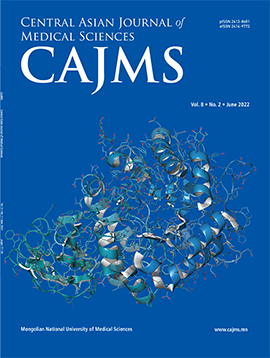Causes and Surgical Outcome of Orbital Wall Fractures in Mongolia
DOI:
https://doi.org/10.24079/cajms.2019.09.006Keywords:
Orbital Fracture, Reconstructive Surgery, Enophthalmos, Diplopia, MongoliaAbstract
Objective: To determine causes, clinical manifestations of orbital wall blowout fractures, and evaluate surgical outcomes. Methods: A retrospective study with repeated measurements was conducted in 194 cases with orbital reconstructive surgery between 2002 and 2017 at Orbita Eye Hospital. The analyzed variables were patient age, sex, causes, and clinical manifestation of orbital wall fractures. Surgical outcomes, implant dependent, and surgical approach complications were prospectively analyzed in 60 patients up to 24 months after the initial surgery. Results: Orbital wall fractures were caused by assault in 82.7% of cases, household accidents 9.9%, car accidents 7.4%, and 0% by a sports injury. Diplopia was noted in 16.7%, extraocular movement limitation in 16.7%, enophthalmos in 23.3% for 24 months, or and more following surgery. In 4.2% of cases, prolapse of the orbital fat was noted using the transconjunctival approach, and 16.6% eyelid retraction with scarring in the subciliary approach. Implant displacement was noted 6.6% of cases in which a silicone sheet was used to reconstruct the fracture defect. Conclusions: Assault was the leading cause of orbital fractures, and this most often occurred in young males in Mongolia. Common signs and symptoms of orbital fractures were enophthalmos, diplopia, and extraocular movement limitation. The range of post-surgical enophthalmos, diplopia, and implant-related complications was consistent with those reported by other studies.
Downloads
216
Downloads
Published
How to Cite
Issue
Section
License
Copyright (c) 2019 Mongolian National University of Medical Sciences

This work is licensed under a Creative Commons Attribution-NonCommercial 4.0 International License.




